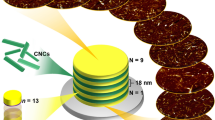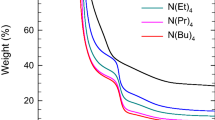Abstract
Utilizing a combination of atomic layer deposition and dip-coating techniques, we have incorporated natural nanocellulose fibers into an inorganic matrix in order to create a layered hybrid inorganic–organic thin-film structure. Such layer-engineered hybrid materials with an unorthodox combination of components are highly potential candidates for exciting new properties. Here, we show a more than an order of magnitude reduction in the cross-plane thermal conductivity for ZnO thin films achieved with the regular inclusion of the cellulose nanofiber layers. We foresee that a similar approach as presented here for ZnO could also be applied to other inorganic materials based on earth-abundant elements to influence their thermal transport properties.



Similar content being viewed by others
References
Klemm D, Kramer F, Moritz S, Lindström T, Ankerfors M, Gray D, Dorris A (2011) Nanocelluloses: a new family of nature-based materials. Angew Chem Int Ed 50:5438–5466
Isogai A, Saito T, Fukuzumi H (2011) TEMPO-oxidized cellulose nanofibers. Nanoscale 3:71–85
Lee K-Y, Aitomäki Y, Berglund LA, Oksman K, Bismarck A (2014) On the use of nanocellulose as reinforcement in polymer matrix composites. Compos Sci Technol 105:15–27
McKee JR, Appel EA, Seitsonen J, Kontturi E, Scherman OA, Ikkala O (2014) Healable, stable and stiff hydrogels: combining conflicting properties using dynamic and selective three-component recognition with reinforcing cellulose nanorods. Adv Funct Mater 24:2706–2713
Hakalahti M, Mautner A, Johansson L-S, Hänninen T, Setälä H, Kontturi E, Bismarck A, Tammelin T (2016) Direct interfacial modification of nanocellulose films for thermoresponsive membrane templates. ACS Appl Mater Interfaces 8:2923–2927
Ye C, Malak ST, Hu K, Wu W, Tsukruk VV (2015) Cellulose nanocrystal microcapsules as tunable cages for nano- and microparticles. ACS Nano 9:10887–10895
Schyrr B, Pasche S, Voirin G, Weder C, Simon YC, Foster EJ (2014) Biosensors based on porous cellulose nanocrystal-poly(vinyl alcohol) scaffolds. ACS Appl Mater Interfaces 6:12674–12683
Wang J, Cheng Q, Jiang L (2014) Synergistic toughening of bioinspired poly(vinyl alcohol)-clay-nanofibrillar cellulose artificial nacre. ACS Nano 8:2739–2745
Olsson RT, Azizi Samir MAS, Salazar-Alvarez G, Belova L, Ström V, Berglund LA, Ikkala O, Nogues J, Gedde UW (2010) Making flexible magnetic aerogels and stiff magnetic nanopaper using cellulose nanofibrils as templates. Nature Nanotechnol 5:584–588
Chen M, Kang H, Gong Y, Guo J, Zhang H, Liu R (2015) Bacterial cellulose supported gold nanoparticles with excellent catalytic properties. ACS Appl Mater Interfaces 7:21717–21726
Chen G (1998) Thermal conductivity and ballistic-phonon transport in the cross-plane direction of superlattices. Phys Rev B 57(23):14958–14973
Giri A, Niemelä J-P, Tynell T, Gaskins JT, Donovan BF, Karppinen M, Hopkins PE (2016) Heat-transport mechanisms in molecular building blocks of inorganic/organic hybrid superlattices. Phys Rev B 93:115310
Giri A, Niemelä J-P, Szwejkowski CJ, Karppinen M, Hopkins PE (2016) Reduction in thermal conductivity and tunable heat capacity of inorganic/organic hybrid superlattices. Phys Rev B 93:024201
Niemelä J-P, Giri A, Hopkins PE, Karppinen M (2015) Ultra-low thermal conductivity in TiO2: C superlattices. J Mater Chem A 3:11527–11532
Hänninen T, Orelma H, Laine J (2015) TEMPO oxidized cellulose thin films analysed by QCM-D and AFM. Cellulose 22:165–171
Qi Z-D, Saito T, Fan Y, Isogai A (2012) Multifunctional coating films by layer-by-layer deposition of cellulose and chitin nanofibrils. Biomacromolecules 13:553–558
Yoon B, Lee BH, George SM (2012) Highly conductive and transparent hybrid organic–inorganic zincone thin films using atomic and molecular layer deposition. J Phys Chem C 116:24784–24791
Tynell T, Terasaki I, Yamauchi H, Karppinen M (2013) Thermoelectric characteristics of (Zn, Al)O/hydroquinone superlattices. J Mater Chem A 1:13619–13624
Tynell T, Giri A, Gaskins J, Hopkins PE, Mele P, Miyazaki K, Karppinen M (2014) Efficiently suppressed thermal conductivity in ZnO thin films via periodic introduction of organic layers. J Mater Chem A 2:12150–12152
Wan C, Gu X, Dang F, Itoh T, Wang Y, Sasaki H, Kondo M, Koga K, Yabuki K, Snyder GJ, Yang R, Koumoto K (2015) Flexible n-type thermoelectric materials by organic intercalation of layered transition metal dichalcogenide TiS2. Nat Mater 14:622–627
Karttunen AJ, Tynell T, Karppinen M (2016) Layer-by-layer design of nanostructured thermoelectrics: first-principles study of ZnO: organic superlattices fabricated by ALD/MLD. Nano Energy 22:338–348
Snyder GJ, Toberer ES (2008) Complex thermoelectric materials. Nat Mater 7:105–114
George SM (2010) Atomic layer deposition: an overview. Chem Rev 110:111–131
George SM, Yoon B, Dameron AA (2009) Surface chemistry for molecular layer deposition of organic and hybrid organic–inorganic polymers. Acc Chem Res 42(4):498–508
Sundberg P, Karppinen M (2014) Organic and inorganic–organic thin film structures by molecular layer deposition: A review. Beilstein J Nanotechnol 5:1104–1136
Gregorczyk K, Knez M (2016) Hybrid nanomaterials through molecular and atomic layer deposition: top down, bottom up, and in-between approaches to new materials. Prog Mater Sci 75:1–37
Tynell T, Yamauchi H, Karppinen M (2014) Hybrid inorganic–organic superlattice structures with atomic layer deposition/molecular layer deposition. J Vac Sci Technol A 32(1):01A105
Degen A, Kosec M (2000) Effect of pH and impurities on the surface charge of zinc oxide in aqueous solution. J Eur Ceram Soc 20:667–673
Alvarez-Quintana J, Martínez E, Pérez-Tijerina E, Pérez-Garcia SA, Rodríguez-Viejo J (2010) Temperature dependent thermal conductivity of polycrystalline ZnO films. J Appl Phys 107:063713
Acknowledgements
The present work has received funding from the European Research Council under the European Union’s Seventh Framework Programme (FP/2007-2013)/ERC Advanced Grant Agreement (No. 339478) and ERC Proof-of-Concept Grant Agreement (No. 712738), Academy of Finland (Nos. 259500, 292431, 303452), the Aalto School of Chemical Technology—VTT Forest Meets Chemistry Programme and from the United States Army Research Office (No. W911NF-16-1-0320).
Author information
Authors and Affiliations
Corresponding author
Ethics declarations
Conflicts of interest
The authors declare that they have no conflict of interest.
Electronic supplementary material
Below is the link to the electronic supplementary material.
Rights and permissions
About this article
Cite this article
Jin, H., Marin, G., Giri, A. et al. Strongly reduced thermal conductivity in hybrid ZnO/nanocellulose thin films. J Mater Sci 52, 6093–6099 (2017). https://doi.org/10.1007/s10853-017-0848-5
Received:
Accepted:
Published:
Issue Date:
DOI: https://doi.org/10.1007/s10853-017-0848-5




